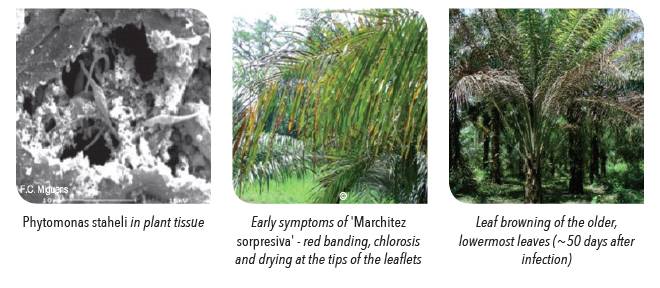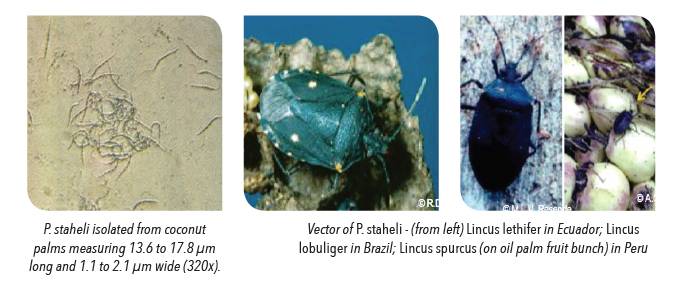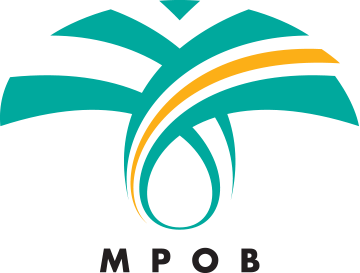General Information

‘Marchitez sorpresiva‘ of Elaeis guineensis Jacq. and hartrort of Cocos nucifera in Brazil are diseases caused by the same pathogen, the protozoan Phytomonas staheli.
Marchitez sorpresiva or sudden wilt is one of the commonest oil palm disease in Latin America. The disease is characterised by the rotting of the spear and apical bud tissues. Other symptoms of the disease include i) browning of the older, lower leaves that progresses upwards to the younger leaves; ii) necrosis of freshly opened inflorescences, iii) premature nutfall of young fruits. Crown foliage may also be affected by secondary bacterial / fungal infection. Palms often die within 2-3 months after the onset of external symptoms, but may vary depending on palm variety.
The protozoan P. staheli inhabit the sieve tubes of host palms. They are transmitted to new host palms by the pentatomids of Lincus spp., which carry the flagellates in their salivary glands. The species of Lincus capable of vectoring flagellates to palms were: L. lethifer, L. cropius, L. apollo, L. dentiger, L. spurcus and L. lobuliger.
Distribution
Caribbean, Central and South America.
Detection and Inspection
The only effective way to detect an infection by Phytomonas would be the demonstration of the presence of flagellates in the plant sap under laboratory conditions. Aetiological diagnosis can carried out by microscopic examination of samples of stem sap. Flagellates can be seen swimming in the fluid. However, flagellates can be rare and flagellate recognition requires well-trained technicians.
Generally, P. staheli is of slender promastigote form measuring 19.9 ± 3.0 μm x 0.6 ± 0.08 μm in Cocos nucifera; and 20.8 ± 3.5 μm x 0.5 μm in Elaeis sp.)
Prevention and Control
PHYTOSANITARY
The import of germplasm material (seeds, pollen, tissue culture) must be accompanied by an import permit issued by or on behalf of the Director-General Department of Agriculture for Peninsular Malaysia (including Labuan), or the Director Department of Agriculture for Sabah, and a phytosanitary certificate issued by an authorised official from the country of export.
The import conditions are available upon request from the Plant Biosecurity Division Malaysia. All consignments are subjected to inspection by the Department of Agriculture prior to clearance by Customs. Germplasm material imported from high risk areas should be sent for third country quarantine before arrival onto Malaysian shores.

CULTURAL CONTROL AND SANITARY METHODS
There are currently no effective treatments of Phytomonas plant diseases, and the best method for infection control is the removal and destruction of hosts/plant material.
Further reading
- Barreto, J M (1982). Marchitez del cocotero asociada con protoarios flagelados (Phytomonas sp.) en al Peninsula de Paria – Estado sucre. Agronomia Tropical, 32(1-6): 291-302.
- CABI CPC (2014). Datasheet on Phytomonas staheli (hartrot (oil palms). Url: http://www.cabi.org/cpc/
- Dolling, W R (1984). Pentatomid bugs (Hemiptera) that transmit a flagellate disease of cultivated palms in South America. Bull. Entomol. Res. 74(3): 473-476.
- Jaskowska, E; Butler, C; Preston, G and Kelly, S (2015). Phytomonas: Trypanosomatids Adapted to Plant Environments. PLoS Pathog.11(1): e1004484. DOI: 10.1371/journal.ppat.1004484
- Mccoy, R E and Martinez-Lopez, G (1981). Phytomonas staheli associated with coconut and oil palm diseases in Colombia. Plant Disease, 66(8): 675-677.
- Mcghee, R B and Mcghee, A H (1979). Biology and structure of Phytomonas staheli sp. n., a trypanosomatid located in sieve tubes of coconut and oil palms. J. Protozoology, 26(3): 348-351.

